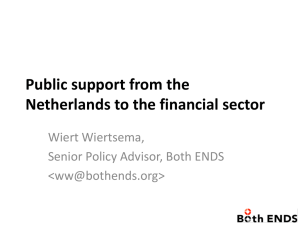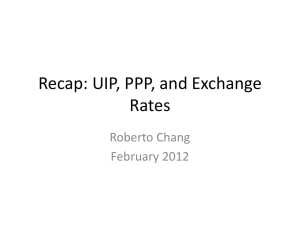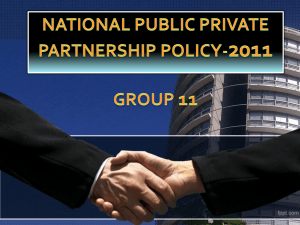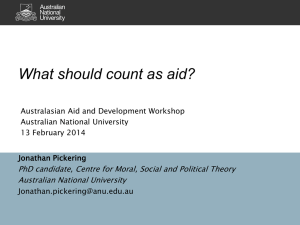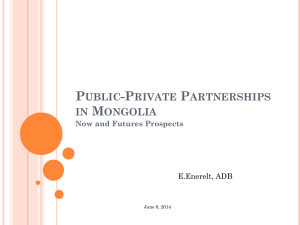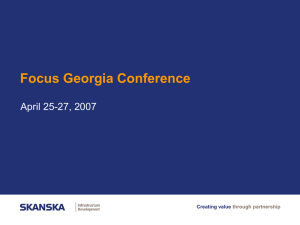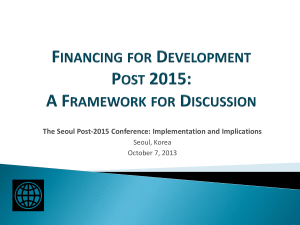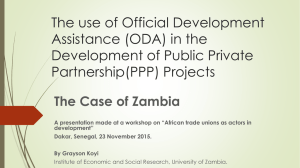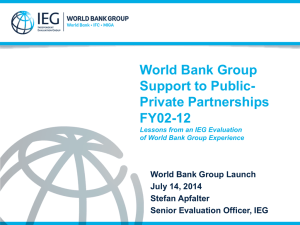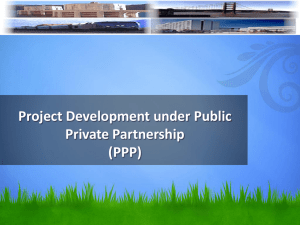The Private Sector and its role in Development Cooperation
advertisement
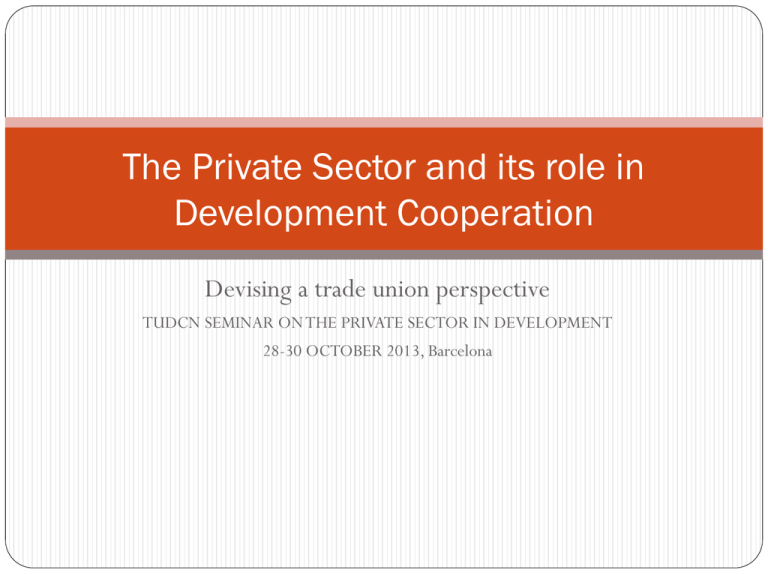
The Private Sector and its role in Development Cooperation Devising a trade union perspective TUDCN SEMINAR ON THE PRIVATE SECTOR IN DEVELOPMENT 28-30 OCTOBER 2013, Barcelona What is it? What is not (but linked to): Private sector development Pro-business regulatory reforms within the domestic arena Incentives for foreign direct investment (tax, EPZ), trade facilitation, access to credit and capital markets “downsizing” of the role of the State (privatisation, ‘corporatisation’ of stateowned companies, sector-wide de-regulation) World Bank “Doing Business” country ranking methodology What it looks like: private sector for development Specific contractual partnerships between a public party (donor, other ODA- related institution) and a private party (MNE, domestic company and/or an investor) for the purpose of achieving specific development objectives Putting a figure Sector distribution of ODA 2006-2011 Distribution of ODA in the top 3 sectors (base 100 = 2006) 180.0 IX. Unallocated / Unspecified 160.0 VIII. Humanitarian Aid 140.0 120.0 VII. Action Relating to Debt 100.0 VI. Commodity Aid / General Prog. Ass. 80.0 IV. Multi-Sector / CrossCutting 60.0 190 180 I. Soci a l Infra s tructure & Servi ces 170 160 140 II. Economi c Infra s tructure & Servi ces 130 III. Production Sectors 150 120 III. Production Sectors 110 40.0 II. Economic Infrastructure & Services 20.0 I. Social Infrastructure & Services 0.0 2006 2007 2008 2009 2010 2011 100 2006 2007 2008 2009 2010 2011 The discussion What is it? Putting a figure Typology The drivers The international agenda Government & private sector drivers The critique Impact on development goals A trade union perspective Typology Commercial based relationships Financial assistance and investments Public procurement & PPPs Networking and policy advocacy Co-financing of local partnerships & networking Advisory services and capacity building programmes Standard setting and policy advocacy Categories of PSD engagement and types of contractual relationship Philanthropic CSR initiative Category of engagement > Private forprofit project Public-private partnership Public procurement, incl. ODA projects Networking, standard setting and policy advocacy Type of contractual relationship Grants X X Public loans X X Public equity X X X X Insurance guarantees Source: OECD & RoA 2012. X & X X Typology of initiatives Role of the public party > Role of the private party Donor Creditor Shareholder Customer Insurer Operator of for-profit project Subsidies Loans Equity investment; PPP PPP Public guarantees, export credit PPP Public procurement; PPP Sub-contractor of public works Recipient of non-commercial benefits Local partnerships & networking; Capacity building; Standard-setting The Burgeoning International Agenda The Busan Partnership for Effective Development Co- operation The Joint statement “Equal partners” The G20 Process Infrastructure under the sun of PPPs Changing the “business model” of MDBs Private investment and job creation Indicators on economic value added and job creation Tax accountability Busan Partnership The shared principles ownership of development priorities by developing countries effectiveness focused on results “inclusive partnerships” accountability through greater transparency to beneficiaries and to citizens at large (“subject to legitimate concerns about commercially sensitive information”) the role of the private sector Engage with “business associations, trade unions and others” on the reform of the regulatory environment for private investment, FDI & PPP; Participation of the private sector in the design of policies Innovative financial mechanisms to mobilise private finance Aid for trade agenda (productive capacities, market failures, access to capital markets and reducing financial and credit risk) Building block Public Private cooperation Joint statement “Lower barriers” to business registration, reforming property rights systems and tax systems use ODA to “leverage private sector investment” including “ blending” Donors & DFIs to help reduce risk management and exposure of private sector. private sector recognised “as an equal” partner The G20 process WG on Development (2010-2012) Open call for PPPs Align procurement rules which PPP arrangements. Support creation of “PPP units” & “PPP practitioner networks”, pooling information on infrastructure projects Construction Sector Transparency Initiative (CoST) to promote competition of PPP procedures Changing the “business model” of MDBs Weak recommendations on private investment and job creation, but good work on tax accountability Work plan on long term investment (2013) Old wine in new bottles Links with workers’ pension funds Shaping Donor Policy – What are the drivers? Government drivers Tied Aid The Public finance gap Promoting private business per se Private sector drivers Access to markets and to policymakers The “inclusive business” model Tied aid “putting Dutch interest first, more so than in the past”; “it is in Sweden’s as well as Sida’s interest that Swedish businesses are suppliers in development assistance-financed calls for tender” “it is a strategic priority in Danish development cooperation to work for a stronger private sector” Italian stimulus package (Decreto Fare ) of June 2013 broadens the list of eligible countries for which Italian companies can benefit of ODA support Source: incl. ECDPM Private sector drivers Access to market USAID-UNICEF-Gates Foundation-Unilever: reducing the risk of viruses “provides an opportunity for Unilever to get access and recognition in new markets” (ECDPM) Busan Building Block « country hubs » promoted by International Business Leaders Forum (IBLF) The « inclusive business » model Turning the poor & the extreme poor into a “USD 5tr. market” (Bottom-of-the-Pyramid) WBCSD, Business Call to Action, IFC Not really inclusive! Source: incl. ECDPM Impact on development goals Little due diligence Reality of Aid 2012 “donors have have undertaken little due diligence in assessing the distributional impacts, or the potential effects of various forms of private sector development on the livelihoods, assets and capacities of poor populations” Audit by the World Bank’s Compliance Advisor/Ombudsman (CAO): the IFC “knows very little” about the environmental or social impacts of its financial market lending” (USD 20 bn) French CAS “the rationale for the [inclusive business] theory is to work on the basis of success stories, thereby omitting projects that may have encountered difficulties” Rights-based approach to development? Busan & G20: references & broad statements are rarely put into practice or implemented with the same level of commitment 7 out of 22 donors have reference, while half made explicit reference to two or more of the common voluntary standards or guidelines (North-South Institute & Canadian Council for International Cooperation) Comparing PPPs with public sector procurement Research & literature review by PSI-RU Factor Comparing Evidence indicates Cost of capital Debt interest + dividends PPP more expensive Cost of construction Comparative costs and completion PPP more expensive/neutral Cost of operation Comparative efficiency Neutral Transaction costs Procurement + monitoring, management PPP more expensive Uncertainty Incomplete contracts, contingent liabilities, impact on service PPP riskier Devising a trade union perspective Impact indicators and monitoring Macro: Shielding ODA & ensuring policy coherence Focus ODA on poverty alleviation & access to social security Country ownership and public services Micro: Setting conditions to PSD ILO standards and the Decent work agenda Social dialogue as a foundation of inclusiveness Corporate accountability and transparency Shielding ODA “There is obviously a space for PSD, but we cannot accept the they highjack ODA for their own good. Combined with ODA budget reduction, PSD will make it even worst for true rights based approach (like ours) and communities alternative development projects”. “unacceptable that ODA be spent for the growth of their domestic enterprises, when they already do have many other canals to support their development.” “trade unions should qualify the private investment firms as an investment and not as ODA” Country ownership and public services Capacity building Democratic and inclusive ownership of development In contrast to traditional public procurement, PPPs have many hidden costs and are excessively complex contracts for governments to handle. Conditions for PSD ILO standards and the Decent work agenda Social dialogue as a foundation of inclusiveness Corporate accountability and transparency
